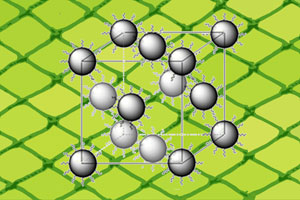Zinc oxide nanocrystals that self-assemble into 'superlattices' are promising luminescent materials, say scientists in China.
Jie-Sheng Chen and co-workers at Jilin University, Changchun, have found that zinc oxide nanocrystals capped with ionic liquids spontaneously assemble into a three-dimensional lattice. The researchers say that simply drying a solution of the modified zinc oxide nanocrystals is all that is needed for the superlattice to form. The presence of the ionic liquid prevents the nanocrystals from aggregating.

Larger nanocrystals pack in a 'face centred cubic' arrangement
|
Hongyou Fan, a materials scientist at Sandia National Laboratories, New Mexico, US, said the surfactant-like nature of the ionic liquid capped nanocrytals is important. '[These nanocrystals] could behave like a block copolymer, providing new opportunities to form varied mesostructured arrays that can't be achieved based on nanocrystal surface chemistry and shape,' added Fan.
By starting out with nanocrystals of different sizes, Chen's team were able to make lattices with different packing arrangements. And, for the first time for this type of material, the researchers characterised the structure of the lattices by x-ray diffraction.
The superlattice materials maintain their nanocrystalline properties and also show stable, tuneable photoluminescent emissions. This means they could be promising candidates for the future development of luminescent materials.
Chen plans to expand the work to other types of nanocrystals, such as magnetic nanocrytals. 'In principle, these particles may also form superlattices and new properties may be exhibited,' said Chen.
Emma Shiells




